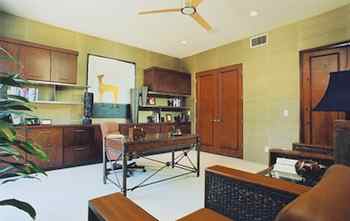By Kathryn Weber

With plenty of storage and file space, and with its desk placed in the center of the room, this home office avoids looking too homely and emphasizes organization, comfort and productivity.
It's estimated that today as many as half of all small businesses are home-based. And more and more employees are spending at least some of their work hours in the comfort of their own homes.
Not surprisingly, then, the home office has evolved well beyond a desk in the corner of the bedroom from which to type out a few e-mails. Dedicated rooms are now required to support breadwinners and entrepreneurs alike. When they're set up with an eye toward organization and style, home offices make their users more comfortable, efficient and productive.
They mean business
Too often, a home office is a mish-mash of furniture taken from other rooms in the house, and that's a major mistake. Although most home offices aren't used for client meetings or even intended for outside visitors, that doesn't mean they should skimp on executive style. In fact, a home office should look like an office, not like a room in a house that's being used as an office.
How do you work?
One of your first considerations when designing a home office is how you work. If your work requires looking at plans or preparing reports, then a wide-open workspace is critical. If you spend lots of time on the computer, avoid the tendency to turn the desk toward a wall. While convenient for using power outlets, that arrangement can make you feel boxed in and like you're in a cubicle instead of an office.
Be sure to have adequate storage, with as many cabinets, drawers and bookshelves as you need. Select closed cabinetry to make the office look neater and reduce visual clutter. Open shelves are nice, but they quickly become cluttered and make an office look messy.
Work comfortably
The majority of office work is done while seated, so a quality desk chair is an important purchase. Select a comfortable one that supports your arms, neck and back. Another key seating requirement is a chair or sofa for visitors to sit in, even if your only visitor is your kid stopping in after school to talk about homework. A sleeper sofa will give you seating and can do double duty for overnight guests. If you spend lots of time at the computer, consider adding a footrest under your desk. Lastly, make sure to test the keyboard drawer before making any office furniture purchase. Many beautiful -- and expensive -- desks aren't really suited for heavy computer use, so take time to test this feature thoroughly before making the investment.
The smart office
Your office should be a space that works for you, so make sure you arrange your office thoughtfully. If you rarely talk on the phone, consider placing the phone on a credenza behind you. The same goes for files. This will free up more open space on your desk. Lighting is another important factor. Turn the computer monitor so that the back of the monitor faces a window to reduce glare and give you a view. Don't overlook lighting, and be sure to include task and ambient lighting to reduce eyestrain.
Designed right, a home office will combine the comforts of home and the efficiency of an office, which will help you be more productive and make your time on the job more enjoyable.
Available at Amazon.com:
Cut Your Energy Bills Now: 150 Smart Ways to Save Money & Make Your Home More Comfortable & Green
It's Easy Being Green: A Handbook for Earth-Friendly Living
Copyright © Kathryn Weber, Living Space. All rights reserved.
AUTOS | HOBBIES | EDUCATION | FAMILY | FASHION | FOOD & RECIPES | HOME DECOR | RELATIONSHIPS | PARENTING | PETS | TRAVEL | WOMEN
Home & Garden - How Your Home Offices Can Make You More Productive